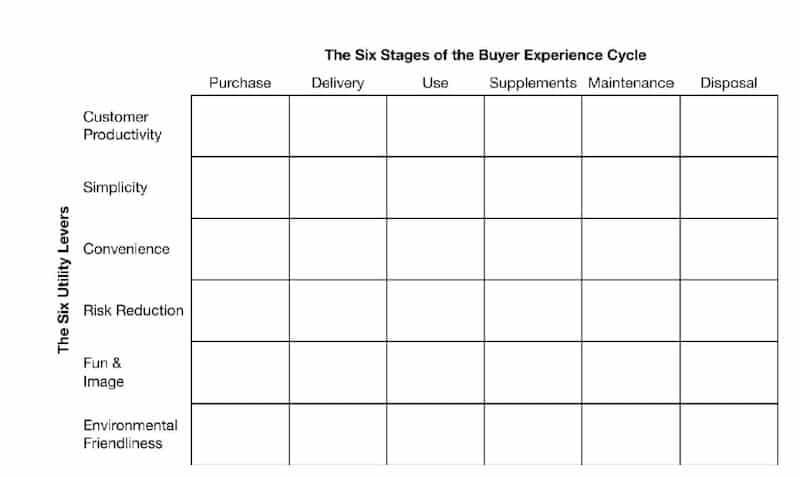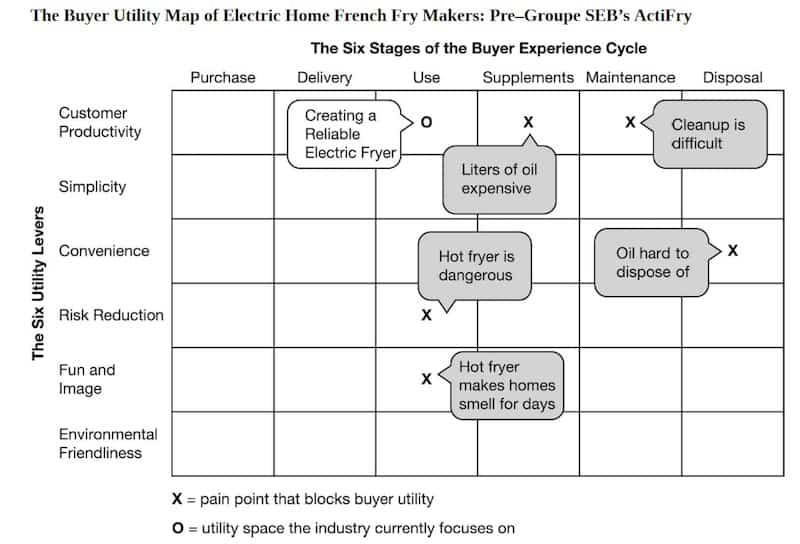Buyer utility map is a tool from the Blue Ocean Strategy that allows you to visually map out the entire buyer’s journey against certain criteria. Along with the strategy canvas, this tool helps you uncover opportunities that everyone else is taking for granted.
In this article, you’re going to learn what the buyer utility map is and how you can find hidden opportunities in your industry. You’ll also get so see some real-world examples of how companies are using it to deliver value to their customers.
But first, what is the buyer utility map?
It “…helps to get managers thinking from a demand-side perspective [aka buyer side vs company side]. It outlines all the levers companies can pull to deliver exceptional utility to buyers as well as the various experiences buyers can have with a product or service.”
It’s composed of two axes: along the horizontal axis is the buyer experience cycle, and the along the vertical axis are the utility levers. I’ll go over this in a bit.
But first, here’s how it looks like…

The biggest benefit of using this tool is after completing the buyer utility map for your product/service, you will easily see areas where the industry is focusing on — and ignoring, which you can capitalize on.
“Few industries or organizations realize how many utility spaces they could explore or, on the flip side, the narrowness of their current focus.”
Blue Ocean
Buyer Utility Map Examples
Here’s an example of the buyer utility map for the French fryer ActiFry.

From the image above, you can see the areas along the buyer experience (from purchase to disposal) where the industry is focusing on—namely, use and customer productivity cell (the one with the O).
And if you look at the other “cells” in the map, you’d see that there are a lot of areas improvements to be made (the X’s), AND a lot more where the industry is choosing to ignore (all the blank spaces).
I’ll discuss more about this in some future posts. If you want to learn more about how to use the buyer utility map for your organization or how to implement a blue ocean strategy, feel free to reach out.
But for now, let’s define the different components of the buyer utility map.
Find Hidden Opportunities in Your Industry
Two Components of the Buyer Utility Map
There are two dimensions in the buyer utility map: buyer experience cycle and the utility levers.
Buyer Experience Cycle
The Buyer Experience Cycle is “a buyer’s experience broken into a cycle of six stages, running more or less sequentially from purchase to disposal.”
These six stages are as follows:
- Purchase
- Delivery
- Use
- Supplements
- Maintenance
- Disposal
Questions to answer at each stage
- Purchase
- How long does it take to find the product you need?
- Is the place of purchase attractive and accessible?
- How secure is the transaction environment?
- How rapidly can you make a purchase?
- Delivery
- How long does it take to get the product delivered?
- How different is it to unpack and install the new product?
- Do buyers have to arrange delivery themselves?
- If yes, how costly and how difficult is this?
- Use
- Does the product require training or expert assistance?
- Is the product easy to store when not in use?
- How effective are the products features and functions?
- Does the product or service deliver far more power or options than required by the average user? Is it over-charged with bells and whistles?
- Supplements
- Do you need other products and services to make this product work?
- If so, how costly are they?
- How much time do they take?
- How much pain do they cause?
- Maintenance
- Does the product require external maintenance?
- How easy is it to upgrade and maintain the product?
- How costly is maintenance?
- Disposal
- Does use of the product create waste items?
- How easy is it to dispose of the product?
- Are there legal or environmental issues in disposing of the product safely?
- How costly is disposal?
You probably noticed that the questions in the supplements section were the big revelation about the creation of the ActiFry.
“Do you need other products/services to make this work?”
That is the main question ActiFry sought to solve.
Fryers often require oil to cook the food. Lots of it. But by asking the question and realizing that it’s a major pain point for the normal consumer, they went back to designing a new kind of product.
Which questions strike you the most? Did you see some of the more well-known companies apply the same questions to modify their own offering? Apple, Amazon, Google?
Utility Levers
The Utility Levers are “the ways in which companies unlock utility for their customers.”
These levers are as follows:
- Customer Productivity
- Simplicity
- Convenience
- Risk
- Fun and Image
- Environmental Friendliness
Each of these levers are self-explanatory.
Questions to ask for each lever
You ask the following question for each utility lever:
“What are the biggest blocks to (insert utility lever here)?”
Most often, products/services are full of “fluff” that consumers don’t care about. This is backed by the fact that most companies fail because they don’t have a product-market fit. Meaning, what they created was technologically innovative but doesn’t add real value to consumers.
Remember, value innovation is not the same as technology innovation.
So, What Are You Going to Do Next
The main goal of going through the buyer utility map is to determine if your offering genuinely creates new and exceptional utility.
If your offering doesn’t eliminate these blocks for customers and noncustomers, chances are, your offering is innovation for innovation’s sake or a revision of existing offers.
Now that you’ve learned the basics of the buyer utility map, it’s now time for you to take advantage of this tool so you can get ahead of your competition.
Complete the buyer utility map for your product or industry. Once you’re done, with that, you’ll be able to see where the industry is focusing on — what you and your competitors are investing heavily on.
Once you realized how much of the buyer experience cycle or the utility levers the industry is taking for granted, you can use this knowledge to address those gaps. You can either develop an entirely new offering or use that to upgrade your existing offering.
Find Hidden Opportunities in Your Industry
Frequently Asked Questions
What is the buyer utility map from the Blue Ocean Strategy?
The buyer utility map is a tool from the Blue Ocean Strategy that allows you to visually map out the entire buyer’s journey against certain criteria.
How can I use the buyer utility map?
You can use the buyer utility map to find opportunities the entire industry is taking for granted. It shows you where the players are heavily investing in, what the customer pain points are, and gaps that you can take advantage of.
What is the buyer experience cycle?
The buyer experience cycle are the stages people go through, starting more or less sequentially from purchase to disposal. This represents the horizontal axis in the buyer utility map.
What are the 6 utility levers?
The 6 utility levers in the buyer utility map are the ways in which companies unlock utility for their customers. This represents the vertical axis in the buyer utility map.
Have you ever tried using the buyer utility map before? Or need help completing the map for your company? I’d love to help. Let me know in the comments below.
13 thoughts on “Buyer Utility Map: Find Opportunities in Your Industry to Make Your Competition Irrelevant”
Who fill the buyer utility map? Managers or buyers?
You. Or anyone who wants to make changes. You fill it out from the buyer’s perspective.
A simple analogy will be features and benefits. Features are from comoany perspective while benefits are from buyer’s.
But the utility map goes beyond the benefits. Instead of just looking at what how it benefits them, you look at it from the entire customer journey and along a fixed criteria. Those that really matter.
How do you go about looking for customer pain points. What is the best and easiest way?
Best way is to ask them. Or observe. Go through the entire buying process from their perspective. A focused group discussion might also be worth it.
The problem usually is that business leaders don’t do this from their buyer’s perspective and so out of tune with what’s happening on the ground. That’s why so many of these pain points are neglected.
Let’s say you’re a grocery, listen to what people say or look at their body language and facial expressions.
A line is forming—do customers like that? Most likely no. So what can you do to remedy that? Provide more self checkout counters or offer a pickup or delivery option. Or some other way to checkout faster.
Which is what Amazon go did. No lines and everything. Pick your items then head out. Done.
If you’re a marketing agency, at which part of the process do customers complain about the most? Is it the unending onboarding questionnaire? Reports and deliverables? Let’s say it’s about the approval of work. You’re doing the creatives and you need approval from clients. Old school is sending a PDFs of these creatives then client checks them and provide feedback.
How do you remove this pain point for both you and the client? There are softWares that allow you to do this where you upload and schedule your creatives and copy. Then client has access, approves or adds feedback directly. If client approves, post is scheduled directly making everything So much easier.
There are a lot of ways and finding the best one is different. My usual suggestion is always g thru the process yourself. Offering a course? Sign up as a new student using another email account to see all the emails and sequences and everything.
Online store? Try buying an item from your own store and see everything until it gets delivered.
You will almost always find something.
How do you define Customer Productivity here?
What kind of things are being sought at this point?
I look at it this way—is what they are trying to accomplish help them be more productive with their daily stuff. In a way, it’s linked to convenience.
Online shopping vs traditional in-store. Former is more Convenient and improves productivity. You can do it while doing other stuff. Amazon, for example, you can order supplies in one voice command via Alexa.
The organisation I work with bought a CMS software, in the year 2020. The software promised a lot – but very late to deliver some areas where we need the most. Now Yr 2021 – we are looking at different CMS software, can i use buyer utility map for this case to show to the organisation board by comparing with different software providers offers and CMS we have at present.
In the graph – will the utility lever and buyer experience level change.
Hi,
Do you have examples from BtoB industry? I can find many examples from BtoC. Thank you!
When working on your to be strategy canvas, where (how) in the six paths insights for your Four Actions Framework and resulting ERRCs do you connect/utilize the learnings from the buyer utility diagram? Thanks!
Hi. Do you have examples of a buyer utility map for a 4g modem that acts as a wifi router?
May I know what is the difference between Buyer Utility Map and Across Complementary Products/Services?
please can you explain customer productivity
is this map . are we checking customer buyer metrics with respect of utility.
For e.g , how can check purchase metrics with respect of fun & image ?